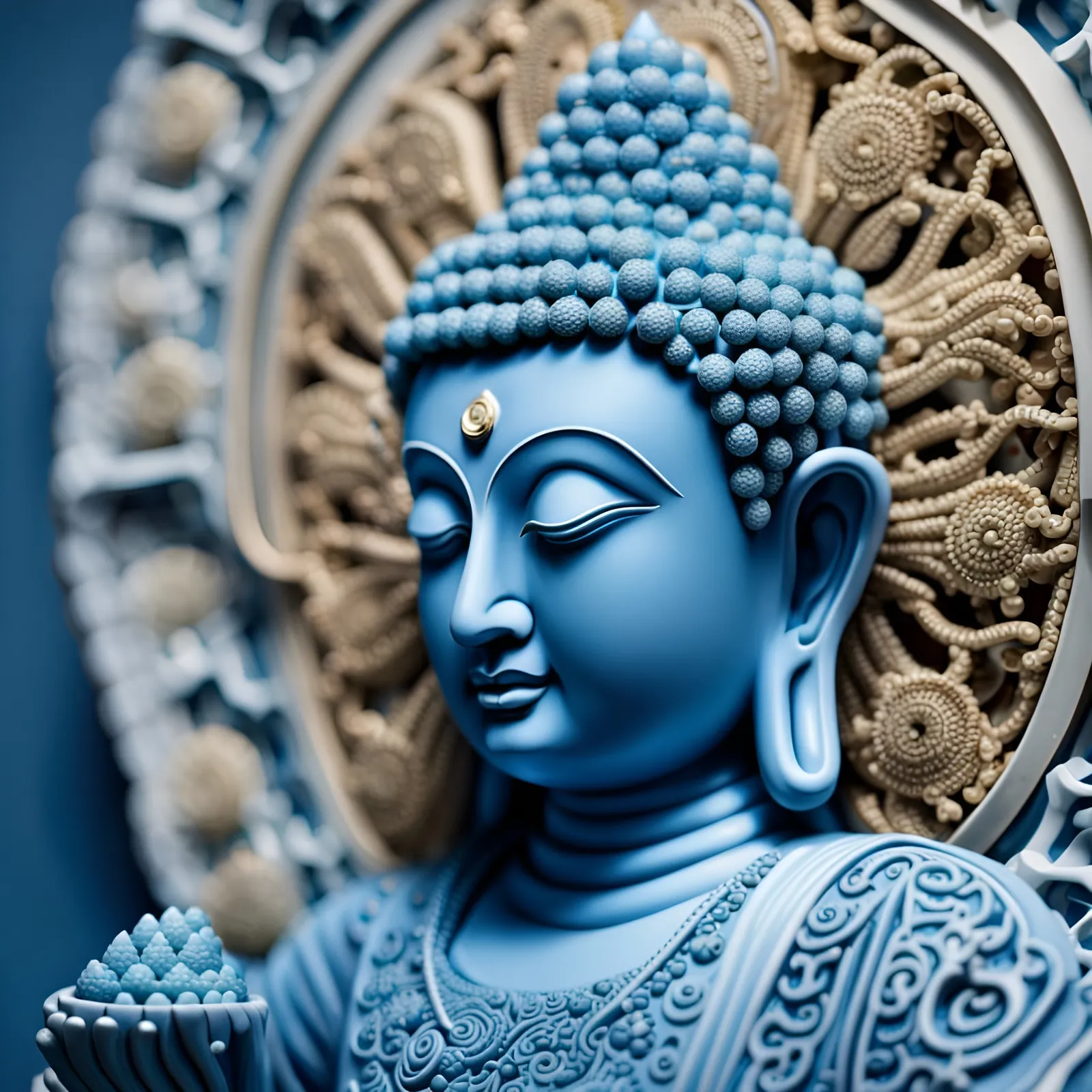Lucknow: A stupa is a construction in the form of a mound used to house Buddha’s relics or the ashes of highly realized Buddhist monks, serving as a memorial. Stupas are also built to mark locations of profound deeds associated with Lord Buddha. With unflinching devotion, when individuals use them for self-reflection, it inspires to accumulate merit and purify inner defilements that obstruct to perceive the reality. The Stupa holds an important aspect of ritual practices as devotees usually does circumambulation.
The term stupa is derived from Sanskrit (स्तूप) literally means ‘heap,’ while The Tibetan Buddhism called as chodten (Wylie: mchodrten) meaning “basis of offering or object of offering and veneration.”
Furthermore, definition of Stupa is stated, “Embodiment of Dharmakaya, from the state of non-arising appears the conventional image of Stupa. The Stupa takes birth from the relics of ultimate Dharmakaya, which is by nature unchanging thus called Stupa.”
The stupa represents the Mind of Lord Buddha and is a source of merit and happiness, inspiring followers to work on transforming the mind from impurity to purity. Stupas are constructed all around the world as a reminder of the Pristine Mind of the Buddha, encouraging individuals to study the nature of mind.
Origin of Stupa
In the Mahaparinibbanasutta, Lord Buddha instructed his disciple that his body, after his death, should be cremated and the relics distributed, with stupas constructed upon them. More than 2500 years ago, after the cremation of Lord Buddha in Kushinagar, a Brahmin named Drona divided the relics of the Buddha into eight equal portions to be shared among eight kings who had sent envoys and armed forces to Kushinagar for that purpose. The kings including Ajātasattu, king of Magadha; the king of the Licchavis of Vesāli; the monarch of the Sakyas of Kapilvastu; the king of the Bulis of Allakappa; the king of the Koliyas of Rāmagāma; the Brahmin king of Vethadīpa; and the two Mallas kings of Pāvā and Kushinagar. Each king built stupas in their own countries to enshrine the relics, allowing them to be worshipped. Later, the Moriyans of Pipphalivana received the remaining ashes of the funeral pyre. Drona, the Brahmin who distributed the relics, received the vat in which the body had been cremated and built a stupa to house the blessed vessel, allowing it to be worshipped.
However, twenty years later, King Ajatasattu opened up the stupas and collected the relics, placing them in a one single stupa southeast of Rajagriha. Anyway, it is believed that the original stupas were all lost or became unidentifiable.
After about two or three centuries, the great emperor Ashoka revived Buddhism and built many stupas to house relics of the Buddha and his significant disciples, as well as to mark the locations of important events associated with Lord Buddha’s life.
Eight Stupas of Lord Buddha
The eight Stupas of Lord Buddha are built to commemorate and celebrate the great deeds of Buddha Śākyamuni.
The Eight Sugata Stupas are:
- Lotus Blossom Stupa (Lumbini)
- Enlightenment Stupa (Bodhgaya)
- Stupa of Turning the Wheel of Dharma (Sarnath)
- Great Miracle Stupa (Shravasti)
- Stupa of the Descent from TushitaHeaven (Sankisa)
- Stupa of Reconciliation (Rajagriha)
- Complete Victory Stupa (Vaishali)
- Mahaparinirvana Stupa (Kushinagar)
Of the eight Stupas, the symbols of four Stupas are in the sacred land of Uttar Pradesh, where Lord Buddha turned the First Wheel of Dhamma, displayed the Great Miracle, descended from Tushita heaven to the human realm, and attained Mahaparinirvana.
Stupa of Many doors/Dhamek Stupa at Sarnath
This Stupa is known as the Dhamek Stupa, representing the First Sermon delivered by Lord Buddha to His first five disciples––Kaundinya, Assaji, Bhaddiya, Vappa and Mahanama––at a deer park in Sarnath, Varanasi. This sermon shows the right path leading individuals to liberation and enlightenment respectively. The Stupa is also known as Stupa of Many Doors, as it features many entrances and steps, embodying the opening of the doors of the Dhamma, the path leading individuals to transform ignorance into awakening. It is square, with four steps and four entrances in each direction, symbolizing the four noble truths, eight entrances symbolizing the eight aspects of liberations, twelve entrances symbolizing the twelve links of dependent origination, and sixteen entrances symbolizing the sixteen aspects of emptiness.
In Praise of the Twelve Deeds of Lord Buddha, it says:
Gazing upon sentient beings out of compassion,
Turned the Wheel of Dhamma in sacred places like Varanasi,
And delivered disciples in the three vehicles.
To you, I pay homage.
Miracle Stupa at Shravasti
This Stupa symbolizes the ‘Great Miracle’ displayed by Lord Buddha at Shravasti, where he was challenged by the six heretical teachers to display His realization and accomplishment. After the six heretical teachers challenged him, Lord Buddha entered a profound state of meditative concentration, and a flame emerged from the hole on the bolt to his door. This flame then fell upon the Blessed One’s miracle pavilion, causing the entire pavilion to catch on fire. However, miraculously, the fire extinguished itself before it could be touched by water. This embodies Lord Buddha’s innate power, which is beyond the comprehension of ordinary beings.
He then emanated a brilliant golden light that suffused the entire world in majestic splendour. He brought his mind into focused awareness, and when he put his foot down on the ground, the great earth began to move. The sun and the moon were shining, blazing, and radiant accompanied by different forms of miraculous signs. Deities residing in the sky offered showers of divine lotuses down on the Blessed One—red, blue, and white ones—and they also offered agaru, sandalwood that had been pounded into powders, as well as tamāla leaves and flowers from the divine coral tree.
He again entered a state of profound meditative concentration, and he disappeared from his seat, rising high into the sky in the eastern direction. He there manifested in the four bodily postures—walking, standing, sitting, and lying down. Then, he entered into the state of mastery over the element of fire, and different kinds of light emerged from his body—they were blue, yellow, red, white, crimson, and the color of crystal. He made his lower body blaze in flames, and then a shower of cold water rained down from his upper body. Thus, the six heretical teachers were thoroughly subdued.Buddhist followers built a Stupa in Shravasti in order to commemorate this event. This stupa has four central extensions, one in each of the four directions, and each extension has four steps.

In Praise of the Twelve Deeds of Lord Buddha, it says:
Through unmatched qualities in the three realms,
Displayed the great miracle in Shravasti.
Through offerings made by gods, humans, and other beings,
Caused the teachings to flourish.
To you, I pay homage.
Stupa of Descent from the Tushita Heaven at Sankisa
Lord Buddha descended from trayastriṃśa, the Heaven of the Thirty-three or Tushita heaven, after teaching on Abhidhamma to his mother and the host of Gods for three months. Queen Māyādevi had died seven days after giving birth to the Buddha and had been reborn in trayastriṃśa as a male god. To show gratitude to his mother and place her on the path to enlightenment, in the seventh year after his Enlightenment, on the full moon day of Asālha the Buddha ascended to the Tushita Heaven to pass the rainy season retreat teaching her the Abhidharma (Abhidhamma) and after three months Buddha descended to human realm along with Lord Brahma and Indra. Buddhist followers built a Stupa in Sankisa in order to commemorate this event. This Stupa is characterized by a central projection on each side containing a triple ladder, signifying Lord Buddha’s descent from heaven to the human world, accompanied by Lord Brahma and Indra. This descent enabled to continue His teaching and deliver ignorant beings in the realm of happiness. Each side of the Stupa has a staircase at the centre of the four steps.
In Praise of the Twelve Deeds of Lord Buddha, it says:
Delivering sermon to the gods, knowing the time had come to tame the human world,
Descending from the god realm like a great elephant,
You foresaw the family of your birth and entered the womb of Māyādevī.
To you, I pay homage.
Mahaparinirvana Stupa at Kushinagar
This Stupa signifies the attainment of Buddha’s Mahaparinirvana at Kushinagar. When Buddha was 80 years old, he realised that his time in this world was approaching an end. At that time, he and some of his disciples travelled on a month-long journey to Kushīnagarthat would take them from Rājagṛha, through Pāṭaliputta, Vesāli, Bhoganagara, and Pāvānagar. It was at Pāvānagar that he took residence at Ambavana, a grove belonging to the household of a man named Cunda, a resident of Pāvānagar. Hearing that the Buddha and his disciples were at his Ambavana, Cunda immediately went to pay reverence and invited the Buddha for a meal called sūkaramaddavaṁ. This proved to be the Buddha’s last meal. While having dysentery the Buddha said, ‘I am going to Kuśinagara.’ Then the Buddha accompanied by the assembly of disciples crossed the Hiraṇyavati River and reached a grove of Śāla trees where he lay down on the ground between a pair of the trees; with his head to the north, face to the west, and feet to the south, he lay as if asleep. The final words uttered by the Buddha were: “वयोधम्मासंखारा, अप्पमादेनसम्पादेय।” after which he closed his eyes and entered Mahāparinibbāna. This Stupa is bell-shaped and unornamented, symbolizing the journey to Mahaparinirvana.
In Praise of the Twelve Deeds of Lord Buddha, it says:
In order to activate the lazy on to the Dharma,
You left your body, though immortal and like a Vajra,
And passed into Mahaparinirvana
In the pure abode of Kushinagar.
To you, I pay homage.





